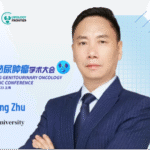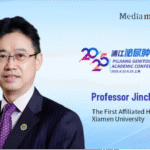
Editor’s Note: At the recently concluded 2025 Pujiang Uro-Oncology Conference, the “High-Quality Development Forum on Urologic Oncology” drew considerable attention as leading domestic and international experts shared cutting-edge clinical and translational research progress. Professor Zhuowei Liu from Sun Yat-sen University Cancer Center (SYSUCC) was invited to present his team’s series of innovative studies in the field of urothelial carcinoma (UC). His talk systematically showcased how investigator-initiated trials (IITs)—ranging from refinements in radical surgery to mechanistic studies of therapeutic resistance—are driving meaningful change in clinical practice and advancing the field. Implementing a Single-Disease Model to Integrate Research and Practice
Professor Liu explained that since 2016, SYSUCC has been a pioneer in implementing a “single-disease management model,” dividing urologic cancers into subspecialty wards for UC, prostate cancer, and kidney cancer. This model has significantly promoted integration between clinical work and research, enabling routine conduct of new drug trials, investigator-initiated studies, and translational research for each disease subtype. These efforts have yielded substantial成果, with results published in top-tier journals such as Cancer Cell (two studies) and European Urology (two studies), and have secured multiple National Natural Science Foundation of China (NSFC) grants each year.
Continuous Refinement of Radical Cystectomy: Simplifying to Solve Parastomal Hernia
Radical cystectomy remains the standard of care for muscle-invasive bladder cancer, yet postoperative complications—particularly stoma-related issues with ileal conduit diversion—remain a major challenge for surgeons and patients. Professor Liu highlighted that parastomal hernia is one of the most vexing complications, often occurring within two years after surgery, sometimes leading to bowel obstruction and severely affecting quality of life.While international centers have explored preventive measures—such as the 2025 prospective study by Memorial Sloan Kettering Cancer Center published in the Journal of Urology, which tested intraoperative mesh placement but yielded negative results—the SYSUCC team took a different approach. “Our method is simple—we bring the ileal conduit out via the extraperitoneal route,” Professor Liu explained. This modification was inspired by their earlier retrospective findings that showed a 16% reduction in parastomal hernia incidence.Building on these observations, the team launched the world’s first prospective, randomized controlled trial in 2019 aimed at preventing parastomal hernia in urinary and gastrointestinal stomas. Patients were randomized to either the modified extraperitoneal group or the conventional approach, with stringent radiologic diagnostic criteria applied. The results were compelling: the modified technique reduced parastomal hernia incidence by 50% without increasing perioperative complications. The study, published in Cell Reports Medicine, provides high-level evidence supporting this simple, reproducible surgical innovation that can be widely implemented worldwide.
Redefining the Extent of Lymph Node Dissection: Prospective Evidence from Asia
Whether extended lymph node dissection (ELND) offers survival benefit in bladder cancer with nodal involvement has long been debated. Professor Liu reviewed two landmark international studies—the LEA and SWOG trials—and noted their limitations, including heterogeneous patient populations and inconsistent use of neoadjuvant chemotherapy.To address these gaps, SYSUCC initiated a rigorously designed randomized controlled trial focusing exclusively on high-risk patients (T3 or higher and N1–N2) who all received standard neoadjuvant chemotherapy. The study compared standard dissection with super-extended dissection up to the level of the inferior mesenteric artery. The results showed no significant advantage for ELND in terms of DFS or OS for the overall cohort. However, a critical subgroup analysis revealed that patients who responded to neoadjuvant chemotherapy (complete or partial response) derived significant survival benefit from super-extended dissection. Professor Liu emphasized that this is the first prospective study of its kind in Asia, and its design and subgroup findings offer a valuable framework for guiding personalized surgical strategies.
Moving UTUC Treatment Earlier: Emerging Neoadjuvant Immunotherapy Strategies
For locally advanced upper tract urothelial carcinoma (UTUC), the POUT trial established the benefit of adjuvant chemotherapy. The SYSUCC team asked whether shifting therapy earlier—into the neoadjuvant setting—could achieve even better outcomes. The key lies in accurate preoperative staging. Through multicenter collaboration, the team leveraged radiomics and deep learning to raise preoperative staging accuracy to 87%, enabling precise patient selection for neoadjuvant therapy.Based on these advances, the group is leading a multicenter, three-arm randomized controlled trial planning to enroll 298 patients, with over two-thirds already accrued. Professor Liu shared that the study design has attracted attention from the former Editor-in-Chief of the New England Journal of Medicine, who expressed great interest in its potential to set new standards for UTUC management.
Tackling Therapeutic Resistance: From Mechanistic Discovery to Clinical Translation
In addition to surgical and perioperative optimization, the SYSUCC team is deeply engaged in unraveling the mechanisms of therapeutic resistance, focusing on both chemotherapy and immunotherapy. Professor Liu noted that antibody–drug conjugates (ADCs) are essentially a form of precision chemotherapy, making it critical to understand the mechanisms of chemo-resistance. Their work in this field has been published in top journals including Cancer Cell, Nature Chemical Biology, Developmental Cell, Nature Communications, Advanced Science, Cell Reports Medicine, Cell Death & Disease, Oncogene, and Cell Reports.In immunotherapy resistance, the team translated mechanistic insights from their Oncogene publication into a phase II clinical trial combining immune checkpoint inhibitors with a domestic HDAC inhibitor in second-line UC patients. The results were encouraging, with an objective response rate (ORR) of 41%, comparable to existing second-line standard-of-care regimens. Moreover, they identified a novel subset of tissue-resident memory T cells (TEMs) associated with immune resistance and developed a novel dual-target CAR-T therapy based on this discovery. These findings were published in Developmental Cell, underscoring their commitment to bridging bench-to-bedside translation.
Conclusion and Outlook
Professor Liu’s lecture provided a comprehensive overview of SYSUCC’s systematic approach to UC management—from organ-preserving strategies and optimized radical surgery to mechanistic exploration of treatment resistance and translational innovation. These investigator-initiated efforts have not only addressed practical clinical challenges, improving survival outcomes and quality of life for patients, but have also generated fundamental scientific insights that contribute to global oncology research. Collectively, they highlight the growing influence of Chinese researchers on the international stage and open new avenues for drug development and personalized precision therapy—allowing the world to benefit from Chinese innovation and expertise.


